Are You A Vanguard? Applications Now Open
By the time the wreckers got to it, the brick two-family house on Cora Avenue was pretty far gone.
It had been empty for years, its top-floor windows busted out and ivy covering half a side wall. Its door was blocked with the dark red plywood that is the trademark of St. Louis’ land bank.
Then sometime last November, its front wall collapsed, leaving a gaping hole and a pile of bricks. The house was officially condemned and put on an emergency demolition list. The demo permit came through in April and by the first of June, the two-family that had stood for a century had been replaced with a grassy lot. Another piece of The Ville — a neighborhood that was once the heart of the city’s African-American middle class — was no more.
In a lot of shrinking Rust Belt cities, this kind of demolition is a daily thing.
Battered by foreclosures, Cleveland has launched an aggressive teardown campaign. Flint, Mich. for years has knocked down old houses and banked the land. Detroit Mayor David Bing has pledged to demolish 10,000 vacant homes in his first term and has planned to reduce city services in under-populated neighborhoods.
Like those cities, St. Louis has lost more than its share of people — from a peak of 850,000 residents in 1950 to fewer than 320,000 today — and contains the desolate landscapes to show for it. Like those cities, St. Louis has torn a lot of buildings down (8,000 in the last decade). Like those cities, teardowns here are often supported by neighbors who know what trouble can reside in a rotting empty.
But unlike some of its Rust Belt cousins, there has been no talk of systematic service reduction here, no big plans for urban farming or new green space. In fact, all that demolition has happened alongside a growing push to save the city’s trademark red brick architecture, and to turn some of these eyesores into assets, anchors to help rebuild these neighborhoods before they’re gone completely.
There are parts of town where this has worked. In neighborhoods across south St. Louis, and in pockets of the more abandoned north side, rehabs have drawn new residents and sparked businesses. It’s been a largely organic, if somewhat haphazard, process with no guarantees of success. But it has made a noticeable difference.
Now the push to save building stock has spread into neighborhoods that are harder hit by decay, where the tension between preservation and demolition is playing out on a block-by-block, house-by-house level. And the lessons being learned can echo in places far beyond The Ville.
Of all the neighborhoods on St. Louis’ mostly African-American north side, maybe none has more cultural import than The Ville. In the early 20th century, in segregated St. Louis, it was the place where many of the city’s leading black institutions clustered.
At its center sat Sumner High School, the first African-American high school west of the Mississippi and alma mater of Arthur Ashe, Tina Turner and Chuck Berry. On the blocks around Sumner there was a teacher’s college, a big cosmetology school and prominent churches. And in 1937, the city opened Homer G. Phillips Hospital, the only hospital in north St. Louis and the nation’s leading teaching hospital for black doctors.
With all these schools and hospitals came middle-class homeowners. For much of the first half of the 20th century, restrictive real estate covenants made it hard for African Americans to buy houses in many St. Louis neighborhoods. But not in The Ville. So black doctors and teachers and nurses bought up the brick homes where they could walk to work and be part of a community.
“This was a good neighborhood,” said Harold Crumpton, who grew up in The Ville in the ’50s and now heads the Greater Ville Neighborhood Preservation Commission.
Here and there, you’ll see a building afflicted with “dollhouse syndrome,” its interior walls and staircases standing naked after thieves tore away the outer walls to sell the bricks for 25 cents apiece.
It was the end of segregation that started to change this. In 1948, the Supreme Court struck down St. Louis’ system of restrictive covenants, and black professionals gradually started moving west, into bigger homes left behind by white families who themselves were heading west to the suburbs. Manufacturing and meatpacking jobs slipped away, and one by one the drug stores and shoe stores along Easton Avenue closed, to be replaced with taverns and Laundromats. By the time the city shuttered Homer G. Phillips in 1979, The Ville was falling fast.
Today it is just plain fallen.
In 2010, about 8,000 people lived in The Ville and a surrounding neighborhood known as The Greater Ville, according to the Census. That’s down 26 percent from 10 years prior, a pace of decline that’s held for three decades now.
“We’ve lost probably 70 percent of our population,” said Crumpton. “What’s left are children and senior citizens.”
Those who remain are likely to be poor; the median household income hovers around $16,000. What’s left of the commercial strip along Easton — now Dr. Martin Luther King Drive — is mostly car repair shops and corner stores advertising big cans of cheap beer. Sumner hangs on, with a much smaller student body, but five other schools in the neighborhood have closed. A few small factories remain, but only about one in three adults has a job.
Physically, the place has been pounded. In parts of The Ville, a typical block may be half vacant lots, just grass and crickets. The buildings still standing are a hodgepodge of fine old homes, modest brick bungalows and new construction, its beige vinyl siding in sharp contrast amid the red clay. Empties are everywhere, ranging in condition from neat board-ups to ghostly shells, their windows busted and doors ajar to dark, trash-strewn rooms. Here and there, you’ll see a building afflicted with “dollhouse syndrome,” its interior walls and staircases standing naked after thieves tore away the outer walls to sell the bricks for 25 cents apiece. It all can make for a spooky effect, especially on a summer evening when there are families on the porch, kids playing in the yard and dark, crumbling vacants next door.
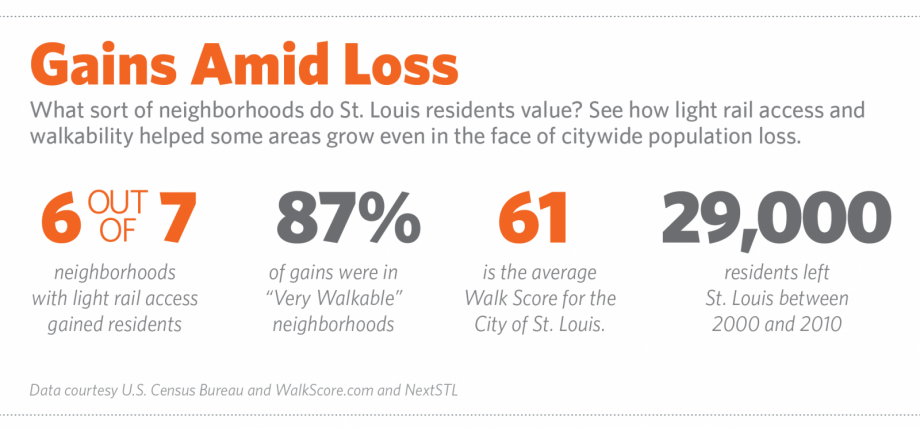
Sam Moore represents the families who still live there. He’s the neighborhood’s alderman, which gives him a great deal of say over development. His solution for many of the empty buildings is pretty simple: Tear them down.
Since taking office five years ago, Moore has OK’d demolition of about 900 buildings in his ward. He’s got a list of 847 more that he still wants to see go. The crumbling vacants are a nuisance, he says, and a danger to their neighbors. They house dumping and wild dogs, drug deals and prostitution.
Some local politicians don’t like to talk about the decline of their neighborhoods, for fear of scaring off investors or seeming too negative. Moore is not one of those. He grew up in The Ville, moving there as a boy when his family’s home was taken in a slum clearance project across town, and it’s been home for most of his life. He wears a Golden Gloves necklace and describes himself as a fighter for his neighborhood. Often that means fighting for attention or resources from anyone who will listen.
Ask him about the state of The Ville and Moore wastes little time before pulling out his cell phone to show pictures of illegal dump sites, or talking about the eight people who’ve been bitten by stray dogs this year. At his desk in the baroque chambers of St. Louis’ Board of Aldermen he keeps blown-up photos of some of the ward’s most decrepit buildings, and he’s been known to brandish them while arguing against yet another subsidy for some downtown project.
“We need help,” he said. “We live in a Third-World community up here. We live like The Flintstones in a Jetsons age. It’s unacceptable.”
And yet with a little help, said Moore, there’s a lot of potential. The Ville is close to downtown. It still has some strong institutions. Unlike far-out suburbs, it has roads and sewers already in place. And all those vacant lots? Moore called them “building sites,” just waiting for a developer to come in with new housing or retail.
This kind of clear-and-rebuild strategy has made a dent in some parts of north St. Louis. In the nearby Jeff-Vander-Lou neighborhood, Habitat for Humanity has built more than 100 new homes in a few square blocks, changing the feel of a once-ghostly place. South of The Ville, housing developer McCormack Baron Salazar is finishing up a 120-unit mixed-use project for the St. Louis Housing Authority. Even Moore’s office sits in a 2-year-old shopping plaza on Martin Luther King, a retail incubator run in partnership with St. Louis University. Every storefront is occupied.
And there’s demand for more, said Moore, pointing to residents who leave the neighborhood to shop or find affordable housing. He sees new homes on the empty lots, and envisions MLK with a bank and a florist, a sit-down restaurant and a drug store. Moore’s even got a spot in mind for Walmart.
He just needs to clean up the supply by clearing out the old stuff no one wants. So Moore badgers the city’s Forestry Division to take down overgrown trees, and the Building Division for emergency demolition funds. As he puts it, some buildings are historic, and others should just be history.
“Land is essential. Prepared land. We want an area where a guy can come in and build a bunch of houses,” he said. “I can’t do it spot by spot and create an area where people will say ‘I don’t mind the wreck next door.’”
And for now, a lot of current residents would like the wrecks gone, too. Just ask Oscar Lang, who lives a few blocks from Homer G. Phillips, in a brick bungalow with tall sunflowers in the front yard. It’s one of five occupied houses in a row, a nice block, he says, with good neighbors. But the next house along, maybe eight feet from Lang’s wall, is a beat-up vacant. Tires in the front yard. Windows broken behind iron bars. Sunlight peeking through the roof.
“It’s an eyesore,” said Lang. “It’s a fire hazard, an insurance hazard, a safety hazard.”
It’s been empty for six or seven years, Lang said, and has been taken by the city for unpaid taxes. He’s looked into buying it to make a side yard, but he can’t afford the $8,000 it would cost to tear the thing down. So he keeps an eye on it, tries to make sure no one gets inside and that his grandkids stay clear when they visit. He’s hoping the city will demolish it soon.
“I guess they’ve got their criteria,” he said. “But the best thing for us would be to tear that down.”
Lang may get his wish. Last October, the city condemned the old house, which puts it on the list for demolition. That’s a long list — there were more than 1,700 condemned buildings citywide — but it moves eventually.
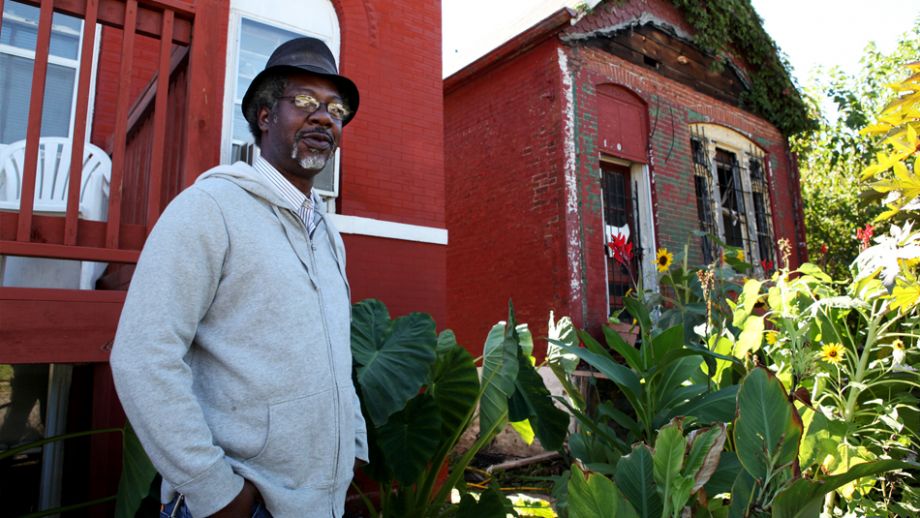
Oscar Lang lives in a brick bungalow on Whittier Street in The Ville. The house next door has been vacant for over five years. Lang hopes the city will soon tear it down.
One morning in August, Moore sat at his desk with 14 stacks of envelopes. Each stack was addressed to residents of a block where a demolition was scheduled in the next month. Inside the envelopes was a letter explaining what would happen and the buildings that were coming down and thanking the neighbors for their patience. Moore planned to go door-to-door and drop them off that afternoon. It’s a good day, he said. Progress.
And yet, there are people who watch what Moore’s doing and wonder if there’ll be anything left of The Ville at all if progress keeps up like this.
“I haven’t seen any neighborhood in St. Louis that lost most of its building stock and ever came back,” said Michael Allen, an architectural historian who has worked across the city.
One thing to know about St. Louis: It’s a brick city.
Thanks to building codes created after a legendary fire in 1849, and to vast clay deposits in the soil of eastern Missouri, nearly every neighborhood within St. Louis’ city limits is full of rich red brick homes. As St. Louis boomed around the turn of the 20th century, even modest worker housing — shotgun row homes and four-family flats — was built with the kind of fine detail that would fetch big money today in Brooklyn or Boston. And those homes were built to last.
In some parts of the city, those everyday brick houses have been the essential ingredients in revitalization. Rehabbers have bought vacant shells, fixed them up and sold them to young professionals and families. With those new residents have come new businesses, jobs and tax revenue.
“So much of the city’s future is based on the asset of its building stock,” said Andrew Weil, executive director of the Landmarks Association of St. Louis. “Take that away, and there’s nothing to compete on.”
Much of that rehabilitation has been sparked by Missouri’s historic tax credit program. Beyond a federal program that reimburses 20 percent of the cost for commercial properties, 34 states have their own historic credits, according to Novogradac & Co., an accounting firm that specializes in tax credits. Missouri’s covers another 25 percent, and can be used for residential properties, too. And it has remade parts of St. Louis.
Over the last decade, over $750 million in state tax credits have poured into the city, fueling a rehab boom that turned dozens of empty warehouses downtown into hip lofts and made handsome homes out of vacant shells across south St. Louis.
But it has been little used on the poorer north side, and in The Ville proper, only one project — the 2003 conversion of a part of Homer G. Phillips into senior apartments — has tapped the program.
To qualify for historic tax credits, a building must be listed on the National Register of Historic Places, either individually or as part of a larger district. For 25 years, preservationists have been working to get The Ville on the list.
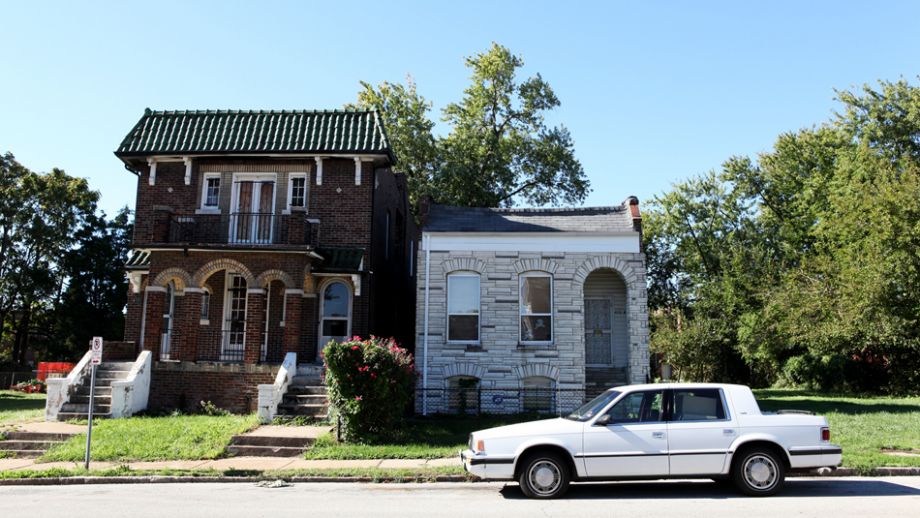
St. Louis officials hope to rehab homes on St. Ferdinand Avenue, directly behind Sumner High School.
Since the mid-’80s, the neighborhood has been a local historic district, but that’s mostly an honorary designation that governs exterior changes. A few buildings, like the Homer G. Phillips complex, qualified on their own for the National Register. But getting the residential streets of The Ville listed has proven harder, in part because, for all their history, the homes themselves are not particularly remarkable.
“Leaving aside its institutions, The Ville is mostly small single-family homes. It’s not very cohesive,” said Jan Cameron, a staffer in the city’s Cultural Resources Office, which oversees preservation efforts. “We tried for many years and were unsuccessful in getting [state and federal preservation offices] to feel there was enough architectural integrity to the property.”
That began to shift in the late ’90s, when the Department of the Interior, which oversees the National Register, began to consider a place’s cultural significance, not just its architecture. Still, it took years to organize and fund the necessary studies. All the while, buildings kept coming down.
Finally, in 2007, five homes of prominent former Ville residents — including the place Chuck Berry lived when he wrote, among other hits, “Roll Over Beethoven” and “Johnny B. Goode” — were listed on the National Register. And last year, the city used some federal grants to survey 370 buildings in the neighborhood for Register status. They found 96, in three districts that “could reveal something about living in The Ville,” which won approval in January. Now those buildings will have receive extra review if anyone wants to knock them down, and can access that state money for redevelopment.
“We’d hope that with these districts in place that there could be rehab,” said Betsy Bradley, director of the city’s Cultural Resources Office. “There’s a lot to be done there.”
One of the districts is right in the core of The Ville, which, for all the neighborhood’s troubles, is still pretty solid. Sumner High School and Homer G. Phillips still stand, two blocks apart. There’s a community center and a pair of old middle schools, closed now but intact. A newly-reopened senior building, an ’80s-style garden apartment complex and several churches. On a pleasant afternoon you can even see a few people out walking their dogs and hear the thuds of football practice at Sumner.
Right behind the high school sit 14 modest houses in a mostly intact row, in what is now St. Ferdinand Avenue in The Ville Historic District. Walking down the block with Allen, who conducted the survey for the city, you can see the potential, and the hurdles, of redeveloping this street.
Allen stands outside a two-story building with a gabled roof, solid-looking but vacant, with boards on the basement windows and weeds growing over the stoop.
“Fix this up and it’s a nice, $60,000 house,” he said, perfect for a first-time homebuyer or single person who works nearby. But even $60,000 is a lot for this part of town, where most of the homes for sale these days are cut-rate foreclosures. And it’s only 900 square feet. There’s been little interest from rehabbers so far.
Of the 14 buildings on the block, about half are vacant, and those are in varying states of disrepair. One is already gone — destroyed by a fire this summer — and another sports a couple of small holes in the side wall, making Allen worry that weather, or brick thieves, might take it down before long.
“Even the buildings we do get listed,” Allen said, “I don’t know if they’ll get saved.”
When you talk with preservationists who work in north St. Louis, you get the feeling that there’s a sort of slow-motion race going on. In one lane is the inexorable spiral of blight, in which a house is abandoned, then taken over by squatters or junkies until fire or weather or scavengers render it so badly damaged that there’s nothing to do but tear the thing down. In the other is a market that’s gradually shifting back toward older neighborhoods and historic homes, helped along with tools like the historic tax credit.
In some parts of town, the preservationists have largely won. Neighborhoods like Shaw (full of large Victorian homes near a large park) and Soulard (with its row houses and lively corner bars) saw activists fight off demolition 20 years ago, and small developers move in to rehab what remained. Now proud brick homes line walkable streets, families and professionals eat at neighborhood restaurants, and the occasional long-term vacant tends to be well boarded, more mothballed than menacing. The market has prevailed.
But in the old inner city of a sprawling, slow-growth region, there are still vast chunks where it hasn’t, where the combination of troubled schools, high crime and few jobs are still driving people out, with no one moving in behind them. That means too many houses, and too little demand.
So buildings crumble and breed trouble, and like a bad tooth they’re better off removed. The economics of saving them just don’t work yet.
“Preservation requires people to disregard short-term problems. It’s not easy, or necessarily fair, to expect that,” said Weil. “These buildings will eventually be assets, but in the meantime there’s a crack head living in there and it might catch fire this winter.”
So they come down. He understands why it happens. Yet there’s a balancing act here. Tear down too many and there’s no neighborhood left, just an urban prairie in a struggling school district. Even Moore knows he’ll never bulldoze his neighborhood back to prosperity.
“There’s 3,500 empties in my ward,” he said. “I can’t tear them all down because then I’d have no community left.”
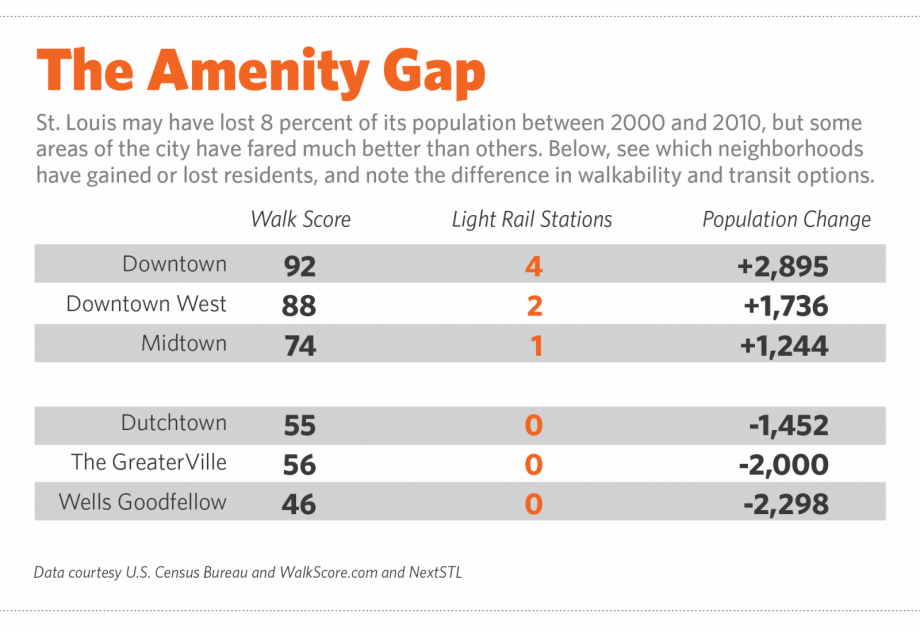
As for Detroit-style service reduction, that’s a very tough sell here. Forty years ago, a city study contemplated shrinking services to shrinking neighborhoods, and it stirred so much anger it was almost immediately shelved. Those who remember it, like Moore, still talk about it with suspicion.
Moore has no intention of abandoning The Ville. He argues relentlessly for more city services, not less. And he touts all the vacant land as an opportunity, not cause to walk away.
The result is not any master plan but a sort of fine-grained triage, a house-by-house analysis of what to build from and what to let go. It’s the kind of view you get riding through the neighborhood with Harold Crumpton, of the Greater Ville Commission. He pulls over every block or two on MLK to point out a building he’d like to buy and rehab. Too many properties along here, he says, are in the hands of people who don’t have the resources to maintain them.
“What’s this person doing with this building,” he says, pointing to a boarded-up storefront with broken windows up top and “No Loitering” scrawled in white paint across the front. “Some of these people are dreaming. They don’t have any money to do anything with them.”
Then he turns on to Marcus Ave and past a row of vacants with crumbling porches and weedy yards. From the front they look salvageable, but the back walls are gone. Several have been condemned.
“When I was a kid these were all fine houses,” he said. “Wasn’t a raggedy house on this block.”
Then he turns another corner, and there isn’t a raggedy house in sight. It’s an intact block of bungalows, with trim yards and cared-for porches. There’s a sprinkler running.
“These people really do have pride in their homes,” he said. “They’re trying.”
The trick is the places in between, figuring how to keep blocks like this one from turning into blocks like the one on Marcus. Often, Crumpton said, it comes down to one or two empties that infect their neighbors. On another nicer block, he slows down in front of a rough-looking two-story with sheets over the windows and trash out front.
“That house is vacant,” he said. “It will take the whole neighborhood down if someone doesn’t get in there and fix it. But fix it right and it will last another 70 years.”
That’s what Crumpton’s community development corporation does. It owns a handful of houses that it has rehabbed and rents out. It screens for good tenants and keeps the homes in shape. Money is tight, and it’s a small-bore program, but it helps.
“There’s 3,500 empties in my ward,” he said. “I can’t tear them all down because then I’d have no community left.”
Still, to really turn a neighborhood like this around, you need a big infusion, said Stephen Acree, president and executive director of the Regional Housing and Community Development Alliance, a non-profit that consults with St. Louis CDCs. You need something that can change the market. This can take many forms, and several are being tried in St. Louis.
One truly massive effort, dubbed NorthSide Regeneration, sits a couple of miles east of The Ville and would remake almost 1,500 acres north of downtown over 20 years, turning swaths of largely vacant land into thousands of homes, office buildings and shopping centers. At its center sits a 33-acre site that once held the Pruitt-Igoe housing project, a complex of high-rises built in the ’50s and famously imploded in the ’70s. Today it’s just an overgrown forest ringed by a chain-link fence, but developer Paul McKee sees it as a place to start something big.
The plan has the blessing of City Hall — which sold McKee a two-year option to buy the Pruitt-Igoe site — and of some community leaders who say no one else has thought with this kind of ambition about north St. Louis in decades. But like a lot of big plans, it has met stiff opposition from some of the people whose neighborhoods it would change. NorthSide has been stalled for more than two years now, bogged down in lawsuits and the weak economy.
Another approach is smaller but concentrated, like when RHCDA bought 36 buildings to fix up in a four-block area south of the bustling hospital complex that houses Washington University Medical School. Along with investment from the university and a budding strip of bars and restaurants, it has helped turn around the whole neighborhood, known as Forest Park Southeast. Now there’s a market-rate apartment building under construction in a long-empty lot there.
“Changing the market takes time,” said Acree. “It’s a longer, sustained proposal.”
But in Forest Park Southeast, it started with the existing fabric and built off an anchor. And in The Ville they’re trying to start that with Dick Gregory Place.
It was four blocks of handsome Richardsonian homes, and in the 1940s it was one of the first places in St. Louis where African Americans challenged racial covenants, and won. It was a proud street. But like so much of the rest of The Ville, Dick Gregory had long since faded. Still that mix of history and building stock was enough to get Dick Gregory Place on the National Register in 2007. That provided an opportunity, said Acree.
“It was like, who’s going to make this mean something?,” he said. “It was an intact pocket of the neighborhood, with access to Martin Luther King and cool buildings. The idea was it would start to knit things back from there.”
So the Greater Ville Commission, RHCDA and Northside Community Housing, Inc., another local group, partnered on a project that would turn 13 buildings on and around Dick Gregory into 40 units of affordable housing. It was mostly rehabs, with two new buildings mixed in. And it would be an anchor, they hoped, that would draw new investment.
The project wasn’t cheap — at $13 million it cost about $325,000 per unit, funded largely with a mix of tax credits and stimulus money — but it was popular. All 40 units were leased a month before Dick Gregory opened last fall. Today it’s a nice pocket, fully occupied with trim yards and new sidewalks. Before-and-after photos of a dozen rehabs are taped in the window of a storefront on the corner, which today is a sunny and open community space, instead of a cinder block-faced tobacco store. The Ville Commission just moved its office next door.
Dick Gregory Place has become an anchor, said Acree, but it needs more weight.
“It only makes sense if you continue to build on it,” he said. “The challenge is can we do more?”
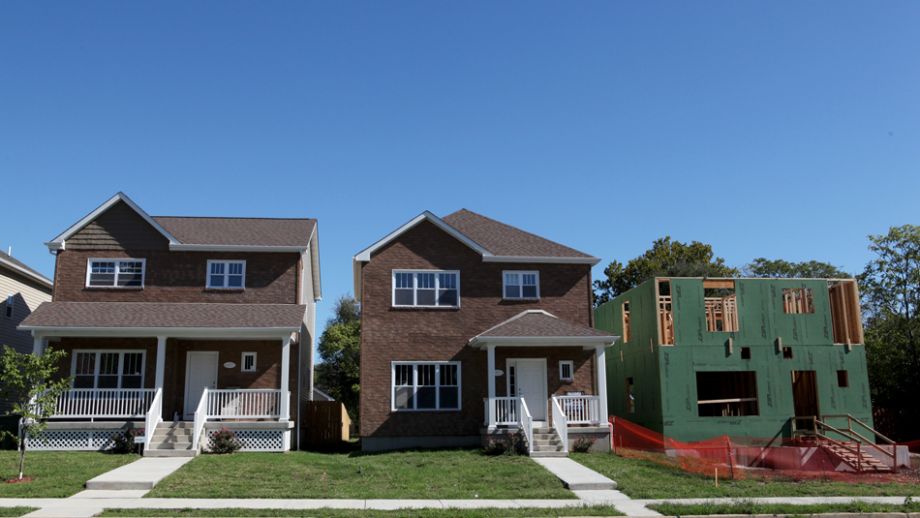
New construction on one side of the 4400 block of Evans avenue. Boarded-up homes remain on the other.
So far the answer has been no. There’s a plan for a second phase of Dick Gregory Place, with more new construction and some rehab, another 31 units for $10 million. Money’s been harder to come by this time, though. The city, which gets lots of requests, recommended other projects for state low-income housing tax credits last year. And so for now, Dick Gregory Phase Two is on hold.
Still it’s a start, said Crumpton. Forty families live there that didn’t two years ago; that’s 40 families that didn’t leave The Ville. It wouldn’t have happened if the old buildings weren’t there to leverage investment.
Buildings alone won’t save The Ville. Not even close. Like any successful neighborhood, it needs jobs and quality schools and safe streets. Preservationists, Weil said, need to remember that demolition is a symptom of a much larger disease, and that the real solutions lie in fixing the neighborhood, not just in saving its buildings.
“You have to create a desirable place, so that a building becomes more valuable than a vacant lot,” he said.
But the more vacant lots there are, the harder it is to create that place. The big plans and outside money aren’t pouring in. Meanwhile the old buildings keep coming down.
On a rainy Friday morning in September, the wreckers were back out on MLK, working on a two-story building that had been in one of those envelopes on Moore’s desk, condemned to be demolished.
The Art Deco facade, still intact, advertised Mutual Cleaning and Dyeing Co., but the place had sat empty for years. Through the upstairs window you could see roof damage, and the demolition crew was taking it down from the back, piece by piece.
They worked quickly. A few days later, Mutual Cleaning and Dyeing was gone, facade and all. In its place was fresh dirt, covered with straw. And what might come next, no one really knows.
Our features are made possible with generous support from The Ford Foundation.

Tim Logan writes about the economy and urban development for the St. Louis Post-Dispatch. He has also worked for newspapers in New York and Indiana, earned a masters degree in urban affairs from St. Louis University, and won national journalism awards, including a Loeb Award for Business Journalism in 2011. He lives with his wife and young son in a brick four-family in south St. Louis that was vacant and abandoned not so long ago.

Emily Rasinski is a photojournalist and multimedia storyteller based in St. Louis. Most recently, she was a staff photographer at the St. Louis Post-Dispatch. Prior to working at the Post-Dispatch, she worked at newspapers in Pennsylvania, Illinois and Ohio. She has won numerous awards for her work. In 2009 she was part of the Pulitzer Finalist team recognized for their coverage of the Kirkwood City Hall shootings. The same year she was also named Runner-up Illinois Multimedia Photographer of the Year. In 2008 the National Press Photographers Association named her third-place Photographer of the Year (small markets).

20th Anniversary Solutions of the Year magazine